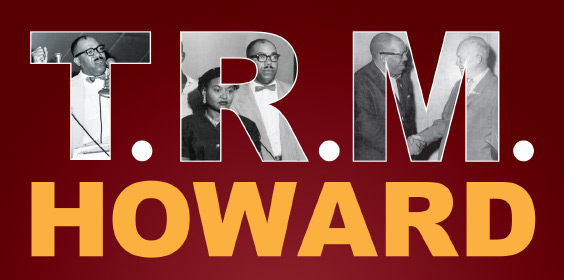The Lighthouse® is the weekly email newsletter of the Independent Institute.
Subscribe now, or browse Back Issues.
Volume 20, Issue 18: May 1, 2018
- T.R.M. Howard Spotlights an Amazing Life of Black Self-Empowerment
- “Free College” Isn’t Free
- Cuba’s Lessons for Millennials
- The Future of Nuclear Power
- Independent Updates

T.R.M. Howard was one of the most accomplished Americans of any era. Born into rural poverty in 1908, this African-American “renaissance man” excelled in every realm he pursued: medicine, public speaking, sports hunting, entrepreneurship, opinion journalism, political activism, and more. His remarkable story has never been told better than in the new Independent Institute book, T.R.M. Howard: Doctor, Entrepreneur, and Civil Rights Pioneer, by historians and Independent Institute Research Fellows David T. Beito and Linda Royster Beito.
Without Howard the U.S. civil rights movement might never have taken off when it did. He mentored or inspired civil rights icons such as Medgar Evers, Fannie Lou Hamer, and Rosa Parks. He organized boycotts to protest segregation. He publicly demanded justice for the murder of 14-year-old Emmett Till—and in doing so drew the wrath of FBI director J. Edgar Hoover. He started medical organizations and a variety of successful businesses. He faced down death threats. He bagged big-game trophies in Africa, with which he furnished his Chicago mansion. He even ran for Congress as a Republican against a Democratic incumbent with strong ties to Mayor Richard J. Daley. These efforts and more landed Howard on national magazine covers, yet too few remember him today. With a foreword by award-winning investigative journalist Jerry W. Mitchell, David and Linda Royster Beito’s compelling and well-researched book helps correct that injustice.
T.R.M. Howard does more than tell the remarkable story of one larger-than-life American. It also sheds light on the little known story of the black middle class, and the tradition of mutual aid, that helped support the civil rights movement. In an age when tragedies of the sort that motivate the Black Lives Matter movement are in the spotlight, T.R.M. Howard reminds us that economic and social advancement are within reach—especially when we stand on the shoulders of giants who broke through past barriers.
Order T.R.M. Howard: Doctor, Entrepreneur, and Civil Rights Pioneer | Book Summary | Reader’s Guide

Sen. Bernie Sanders made “Tuition Free College” a rallying cry of his 2016 presidential campaign. New York, Oregon, Tennessee, and now New Jersey have taken up the idea, at least for community colleges. Despite its initial appeal, particularly in an age of mounting college loan debt, states that offer two free years of higher education may come to regret their decision. Writing in Forbes, Independent Institute Senior Fellow Richard Vedder argues that “free community college” has three major problems that states have yet not successfully addressed.
The first problem is that community colleges have notoriously high drop-out rates—47 percent. Moreover, “completion rates fall the less students pay towards the costs, highlighting that free tuition might raise already scandalously high dropout rates,” Vedder writes. The second problem is that state higher education spending is associated with slower economic growth. If New Jersey pays for free community college by raising its top income tax rate to 10.75 percent, those new community college graduates may find they have a harder time landing a job in a slower-growing Garden State.
The third problem, according to Vedder, is one of equity: “It is unfair, creates poor academic incentives and an un-level playing field when you give free tuition to the academically marginal student entering community college, while her academically superior but perhaps financially similar status classmates face significant tuition charges at four year colleges,” Vedder writes. Clearly, state policymakers genuinely interested in boosting academic achievement must go back to the drawing board. A better approach worth considering, Vedder adds, is a voucher plan similar to K-12 programs in many states.
The Case Against Free College Tuition, by Richard Vedder (Forbes, 4/12/18)
Customized Learning for California: Helping K–12 Students Thrive with Education Savings Accounts, by Vicki E. Alger
Failure: The Federal Misedukation of America’s Children, by Vicki E. Alger
The Academy in Crisis: The Political Economy of Higher Education, edited by John W. Sommer

Two and a half years after Fidel Castro departed this earth for the Worker’s Paradise in the sky, Cuba has a new leader in Miguel Dias-Canel. Raul Castro will still call the shots on the direction of the country, but the new boss will enjoy the limelight. The transition raises numerous questions, especially ones that millennials should be asking.
One involves the absence of Afro Cubans from the country’s leadership, according Independent Institute Policy Fellow K. Lloyd Billingsley. If Cuba fails in that regard, it succeeds at “diversity in repression,” as shown in documentaries such as Nestor Almendros’s Improper Conduct.
“New Cuban leader Miguel Diaz-Canel hasn’t said whether he will release political prisoners, ease up on repression, or allow free multi-party elections,” Billingsley writes. “But as he was careful to explain, Raul Castro and the Communist Party still run the place.”
Lessons for Millennials from Cuba’s New Leader, by K. Lloyd Billingsley (The Daily Caller, 4/25/18)
Video: Alvaro Vargas Llosa and Andy Garcia at “A Gala for Liberty”

Nuclear power may be the safest method for powering industrial civilization, but the disaster at Chernobyl—its thirty-second anniversary was last Thursday—is a fitting reminder that not all power plants are designed with safety in mind. It also reminds us of the cognitive necessity of keeping safety risks in proper perspective, explain Independent Institute Senior Fellow William F. Shughart II and Policy Fellow Brian Isom.
Aside from the meltdown at the Chernobyl-4 reactor in 1986, “no instances of death related to radiation exposure from nuclear power plants have been recorded, even though more than 600 nuclear reactors have been built around the world since 1954,” Shughart and Isom write in The Beacon. “Remarkably, deaths associated with wind turbines over the past decade are three times as high as deaths from Chernobyl, although this statistic gets little if any media coverage.”
The ghosts of Chernobyl still haunt the nuclear power industry, but the technology is moving forward. New reactors are being developed that “are physically incapable of melting down,” Shughart and Isom report. “The world is still a long way from a future of zero carbon emissions, but that goal can be achieved sooner if nuclear energy plays a much larger role in generating electricity,” they continue. “Even today, nuclear provides an opportunity for clean, reliable baseload power that not even wind or solar can match. Throw in the added benefit of producing electricity at a level of safety no other technology can promise and it should be easy to see why it is time to consign Chernobyl to the dustbin of history.”
Despite Enviable Safety Record, Chernobyl’s Ghost Still Haunts the Nuclear Power Industry, by William Shughart and Brian Isom (The Beacon, 4/26/18)
Why Nuclear Power Subsidies Must End, by William F. Shughart II (The Washington Times, 5/23/17)
Video: Michael Crichton on “States of Fear: Science or Politics?”
Electric Choices: Deregulation and the Future of Electric Power, edited by Andrew N. Kleit
The Beacon: New Blog Posts
- Review: Little Pink House Shows How Machinery of Government Undermines Civil Liberties, by Sam Staley
- FinCEN Form 114—I’m Not the Criminal Here, by Robert Higgs
- Leland B. Yeager: 1924-2018, by Randall Holcombe
- The Blindness of Social Wealth, by James A. Montanye
- Despite Enviable Safety Record, Chernobyl’s Ghost Still Haunts the Nuclear Power Industry, by William Shughart
- FDA Issues First Mandatory Recall for Contaminated Food, by Raymond March
- What Gun Control Advocates Can Learn from London’s Knife Attacks, by William Watkins
MyGovCost: New Blog Posts
- The EPA’s Cone of Silence, by Craig Eyermann
- Waste in Federal Spending, by Craig Eyermann
- Why Government Employee Pensions Will Be Taxpayers’ Main Squeeze, by K. Lloyd Billingsley
- Groupthink the Key to Success in Government “Science”, by K. Lloyd Billingsley






